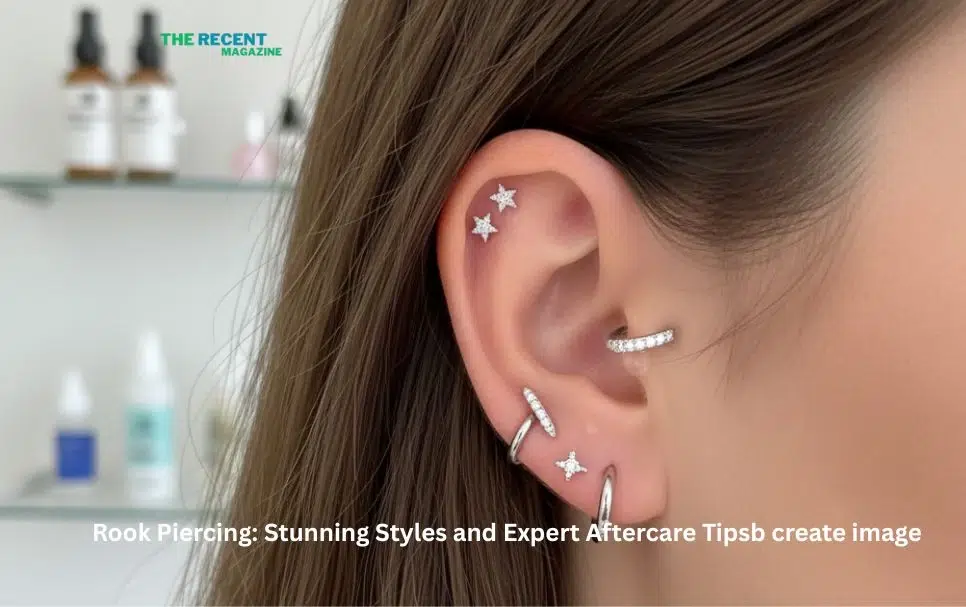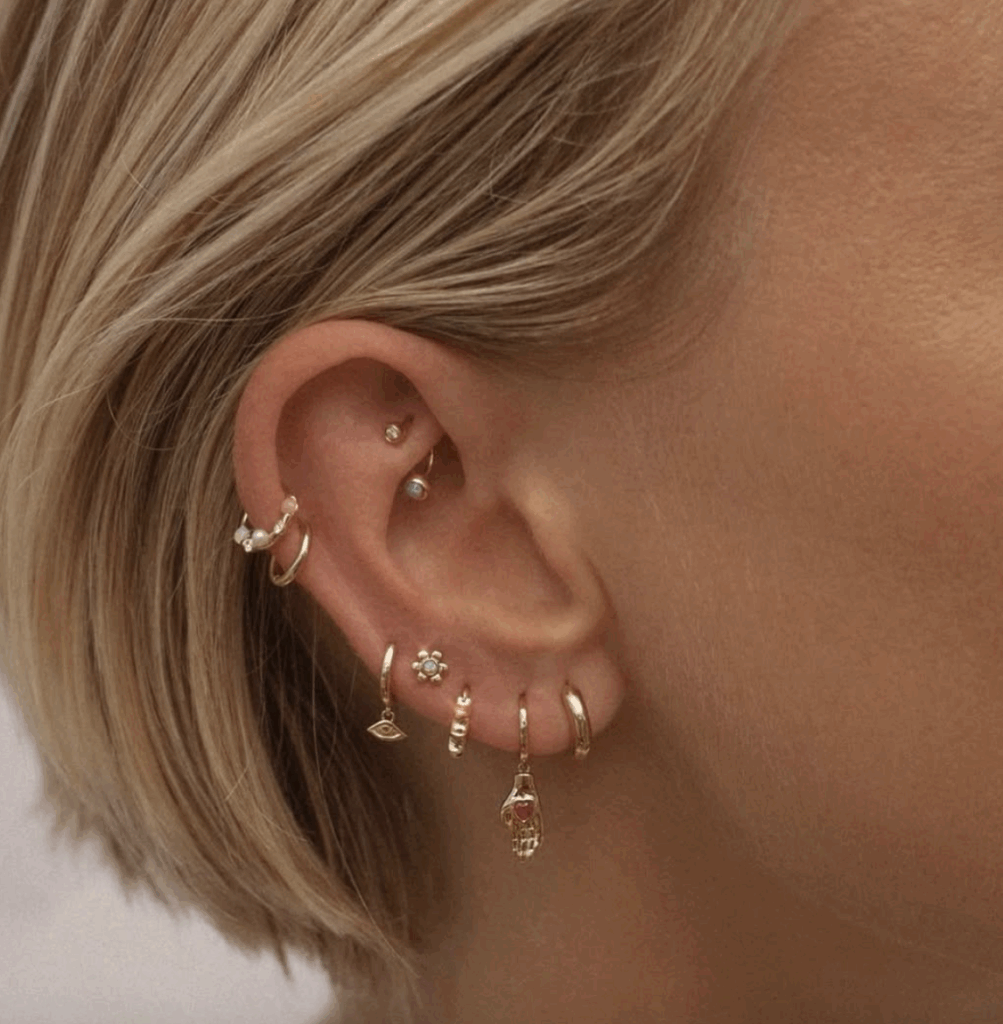Now Reading: Rook Piercing: Stunning Styles and Expert Aftercare Tips
-
01
Rook Piercing: Stunning Styles and Expert Aftercare Tips
Rook Piercing: Stunning Styles and Expert Aftercare Tips

Thinking about adding a Rook Piercing to your ear collection? This unique piercing sits in a bold spot on your ear’s cartilage, giving you an edgy, standout look that’s hard to ignore.
But before you take the plunge, you probably want to know exactly what to expect—from the pain and healing process to the best jewelry options. In this guide, you’ll get clear, straightforward answers to all your burning questions about rook piercings.
Ready to discover if this piercing is the perfect fit for your style and lifestyle? Keep reading to unlock everything you need to know.
Rook Piercing Basics
The rookis the fold of cartilage above the ear canal inside the ear. It is a small ridge that curves inward. This makes the rook piercing stand out and look unique.
Types of jewelry used for rook piercings include curved barbells, captive bead rings, and clickers. These pieces fit the curved shape of the rook well. Choosing the right jewelry helps with comfort and healing.
Popular Rook Styles
Single rook piercingis a popular choice for ear lovers. It sits in the inner ridge of the ear, giving a cool and subtle look. Many choose this style for its unique placement and easy care. Healing time usually takes a few months.
Double rook piercinginvolves two piercings in the same area. This style adds a bold edge and allows wearing more jewelry. It needs careful healing and more attention than a single rook.
Custom and unique designslet people show their style. Piercers can create shapes or add colors with beads and different metals. These designs make the rook piercing stand out and fit personal tastes perfectly.
Pain And Healing
Pain levels during a rook piercing can vary. Most people feel a sharp, quick pinch. Some describe it as more intense than a regular ear piercing. The pain lasts only a few seconds. Swelling and tenderness may follow for a few days. Using ice can help reduce discomfort.
The healing timeline for a rook piercing usually takes 6 to 9 months. Healing is slow because the rook is thick cartilage. Cleaning the piercing twice daily with saline solution is key. Avoid touching or twisting the jewelry to prevent irritation.
Common healing challenges include swelling, redness, and mild pain. Sometimes, bumps or infections can occur. These problems often come from poor aftercare or sleeping on the piercing. Keeping the area clean and avoiding pressure helps healing.
Aftercare Essentials
Clean the rook piercing twice daily using a saline solution. Avoid harsh soaps or alcohol-based cleaners. Gently soak the area for a few minutes to loosen any debris. Use a clean cotton swab to remove crusts carefully.
Keep hands clean before touching the piercing to prevent infections. Do not twist or turn the jewelry as it can cause irritation. Avoid swimming pools, hot tubs, and dirty water during healing.
Apply a cold compress to reduce swelling and discomfort. Avoid sleeping on the pierced ear to prevent pressure. Pain usually lessens after a few days but consult a professional if it worsens or shows signs of infection.
Choosing The Right Piercer
Choose a piercer with proper trainingand certifications. Check if they follow strict hygiene rules. This helps avoid infections and problems.
Ask about their experience with rook piercings. A skilled piercer knows how to place the jewelry safely.
| Questions to Ask | Why It Matters |
|---|---|
| How long have you pierced rook ears? | Experience reduces risks and pain. |
| What jewelry do you use? | Safe materials prevent allergies. |
| What aftercare steps do you recommend? | Proper care speeds healing. |
| Is your equipment sterilized? | Prevents infections and complications. |
Potential Risks
Infection signsinclude redness, swelling, and pain around the piercing. There might be pus or a bad smell. These signs mean the area needs care to stop the infection from getting worse.
Allergic reactionscan happen if the jewelry is made from metal that irritates the skin. Symptoms are itching, rash, or bumps near the piercing. Choosing hypoallergenic jewelryhelps prevent this problem.
Piercing migration and rejectionoccur when the body pushes the jewelry out. The piercing might move or the skin may grow thicker around it. This causes discomfort and might make the piercing look uneven or heal badly.
Jewelry Selection Tips
Material choicesfor rook piercing jewelry affect comfort and healing. Choose hypoallergenic metalslike surgical steel or titanium. Gold is stylish but can cause irritation for some. Avoid cheap metals to prevent infections.
Sizing and fitare key. Jewelry should fit snugly but not tight. Too small causes pain; too large may snag easily. Measure your ear or ask a professional piercer for advice. Proper fit helps healing and comfort.
Styling ideasvary from simple studs to hoops and curved barbells. Small hoops give a classic look. Curved barbells add a unique touch. Pick styles that match your daily activities to avoid damage.
Lifestyle And Maintenance
Sleeping on the pierced ear can cause painand delay healing. Try to sleep on the opposite side or on your back. Use a soft pillowto avoid pressure on the rook.
Avoid activities that may hit or irritatethe piercing. Sports with helmets or headgear can be risky. Stay away from swimming pools and hot tubs until fully healed to prevent infection.
Long-term care includes cleaning the piercing with saline solutiondaily. Avoid touching it with dirty hands. Check for signs of infectionlike redness, swelling, or pus. If any appear, see a professional piercer or doctor.

Frequently Asked Questions
Is A Rook Piercing Painful?
A rook piercing causes sharp pain as it pierces thick cartilage. Expect throbbing and pressure lasting several days. Pain varies but is stronger than earlobe piercings.
What Is The 2/3 Piercing Rule?
The 2/3 piercing rule suggests placing piercings two-thirds up the ear’s cartilage for balanced, aesthetic appeal. This guideline helps achieve symmetry and visual harmony in ear piercings. It ensures piercings avoid sensitive areas, promoting better healing and comfort.
Is The Rook Piercing For Anxiety?
The rook piercing is not specifically for anxiety relief. Some people find ear piercings soothing, but it lacks scientific support. It mainly serves as a stylish cartilage piercing, not a therapeutic treatment for anxiety.
What Does The Rook Piercing Help With?
The rook piercing helps reduce ear cartilage pain and may relieve migraines for some people. It also enhances ear aesthetics with unique style.
Conclusion
Rook piercings add a unique and stylish touch to your ear. They require care and patience during healing. Choose a professional piercer to ensure safety and comfort. Remember, pain varies but usually lessens with time. Proper cleaning prevents infections and speeds recovery.
This piercing suits those wanting something bold yet subtle. Enjoy your new look and express your personal style confidently. Our all updete get to visit our website: therecentmagazine






















